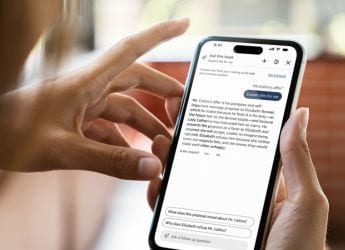- Home
- Telecom
- Telecom Features
- From Landlines to 5G: Tracing India's Telecom Revolution on Independence Day 2025
From Landlines to 5G: Tracing India's Telecom Revolution on Independence Day 2025
Videsh Sanchar Nigam Limited (VSNL) launched the first publicly available Internet service in India on August 15, 1995.

Photo Credit: Unsplash/Eirik Solheim
On Independence Day 2025, we chart India’s telecom revolution and how it happened
On the 79th Independence Day of India, the country remembers its illustrious history, the periods of struggle, and the numerous revolutions that have shaped our modern world. Among all these stories, one that perfectly encapsulates all of these elements is the country's telecommunications story, from rotary-dial landlines to blazing-fast 5G networks, connecting over a billion people and pushing forward India's tech ambitions. This story of transformation finds its roots in 1851, when the first telegraph line was established between Kolkata and Diamond Harbour, and ends in 2025, when the total Internet subscribers in India has reached 969.1 million.
India's Telecom Timeline: The Pre-Liberalisation Era
Telephone services in India arrived fairly early, 1882 to be precise. This was when the first telephone exchanges were established in Calcutta (now Kolkata), Bombay (now Mumbai), and Madras (now Chennai) by the Oriental Telephone Company. Interestingly, this company was established in 1881, with an agreement between Thomas Edison, Alexander Graham Bell, the Oriental Bell Telephone Company of New York and the Anglo-Indian Telephone Company, Ltd.
However, telecommunication technology was still far away from the hands of the people due to limited infrastructure, high cost, and control of the British Raj. During this time, the Calcutta exchange had only 93 subscribers.
Even after India gained Independence, the growth of telephone connections remained slow, as people viewed it as a status symbol instead of a necessity. To get a connection, one had to fill out long forms and wait months, and sometimes years, for the installation. At the time, the Department of Telecommunications (DoT) and MTNL/VSNL (Videsh Sanchar Nigam Limited, later acquired by the Tata Group and was rebranded as Tata Communications in 2008) dominated the scene.
The 1990s Liberalisation Wave
The economic reforms in 1991, which opened the telecom sector to private players, also brought this technology to a lot more people. But it was not until the National Telecom Policy (NTP) of 1994 that private companies began operating in this industry. The NTP also paved the way for foreign investments, which would eventually introduce services such as radio paging, mobile phones, and the Internet.
This period saw the arrival of cellular mobile services in metropolitan cities like Delhi, Mumbai, and Kolkata. Handsets were bulky, calls were expensive (Rs. 16 per minute, incoming and outgoing), and coverage was patchy, but the gates had finally opened. Interestingly, the first mobile call in India was made on July 31, 1995, between then West Bengal CM Jyoti Basu and Union Telecom Minister Sukh Ram.
The Mobile Boom and the Missed Call Culture
The early 2000s were the first time ordinary citizens began owning mobile phones. These were still bulky, and the devices only allowed users to make calls, send SMS, and play the Snake and Tetris games. Still, with the New Telecom Policy (NTP) of 1999, the subscriber base began expanding.
According to Upstox, the teledensity of India increased from 3.5 percent in 2001 to 7.67 percent in July 2004. The number of mobile subscribers alone skyrocketed from just 1.20 million in 1999 to 20.73 million by November 2003. Mobile phone connections rapidly surpassed fixed-line connections around 2005.
A few factors enabled this growth. The turn of the millennium brought about massive GSM and CDMA network rollouts, which led to tariff reductions and the introduction of per-second billing. Handset prices also dropped as affordable Chinese devices flooded the market. This was also the time of mushrooming SMS and ringtone services, and the start of a nationwide phenomenon, fondly known as the “missed call culture.”
Amidst it all, by 2008, India had become the world's second-largest mobile market, surpassing 300 million connections.
The Smartphone and Data Era
If the 2000s were the golden age for telephones, the 2010s marked the Internet revolution in India. The first wave of 3G services hit the country in 2008, led by the telecom giants MTNL and BSNL. With the rise of the Android platform, the smartphone boom occurred, and that ushered in the data era, as people finally had an affordable way to access the Internet.
However, the biggest disruptor of this decade was the rollout of 4G and the LTE technology, first introduced by Airtel in 2012. However, its impact was not felt till September 2016 when Reliance Jio entered the market with free voice calls, zero roaming charges, and ultra-low daily and monthly data plans, a move widely credited with triggering a tariff war that transformed India's telecom landscape.
By 2018, India had become the world's largest mobile data consumer, rising from 155th to the top in global data usage, a feat highlighted by Mukesh Ambani at the India Mobile Congress.
The 5G Era and the Road Ahead
The accelerated growth from the 2010s did not stop, and soon, it was time for 5G. Indian Prime Minister Narendra Modi officially inaugurated 5G services in October 2022 at the sixth edition of the India Mobile Congress. In 2025, major Indian cities and industrial hubs have near-complete coverage from all major telecom providers, while rural rollouts are accelerating.
At the end of March 2025, the total number of Internet subscribers had reached 969.1 million, and the average minutes of usage (MOUs) per subscriber per month hit 1,000. The urban teledensity is now at 131.45 percent, whereas rural teledensity has reached 59.06 percent.
From being in the hands of an elite few to becoming the lifeline for more than a billion people, India, the country's telecom journey has been one of democratisation, innovation, and transformation. As the 79th Independence Day of the country arrives, India is now positioning itself for 6G connectivity and to become not just a consumer market, but a telecom technology hub.
Get your daily dose of tech news, reviews, and insights, in under 80 characters on Gadgets 360 Turbo. Connect with fellow tech lovers on our Forum. Follow us on X, Facebook, WhatsApp, Threads and Google News for instant updates. Catch all the action on our YouTube channel.
Related Stories
- Samsung Galaxy Unpacked 2025
- ChatGPT
- Redmi Note 14 Pro+
- iPhone 16
- Apple Vision Pro
- Oneplus 12
- OnePlus Nord CE 3 Lite 5G
- iPhone 13
- Xiaomi 14 Pro
- Oppo Find N3
- Tecno Spark Go (2023)
- Realme V30
- Best Phones Under 25000
- Samsung Galaxy S24 Series
- Cryptocurrency
- iQoo 12
- Samsung Galaxy S24 Ultra
- Giottus
- Samsung Galaxy Z Flip 5
- Apple 'Scary Fast'
- Housefull 5
- GoPro Hero 12 Black Review
- Invincible Season 2
- JioGlass
- HD Ready TV
- Laptop Under 50000
- Smartwatch Under 10000
- Latest Mobile Phones
- Compare Phones
- Redmi Note 15 5G
- Redmi Note 15 Pro 5G
- Redmi Note 15 Pro+ 5G
- Lava Play Max
- Poco C85 5G
- Honor Magic 8 Lite
- Jolla Phone
- Realme P4x 5G
- Asus ProArt P16
- MacBook Pro 14-inch (M5, 2025)
- OnePlus Pad Go 2
- Poco Pad M1
- Just Corseca Skywatch Pro
- Honor Watch X5
- Acerpure Nitro Z Series 100-inch QLED TV
- Samsung 43 Inch LED Ultra HD (4K) Smart TV (UA43UE81AFULXL)
- Asus ROG Ally
- Nintendo Switch Lite
- Haier 1.6 Ton 5 Star Inverter Split AC (HSU19G-MZAID5BN-INV)
- Haier 1.6 Ton 5 Star Inverter Split AC (HSU19G-MZAIM5BN-INV)

















